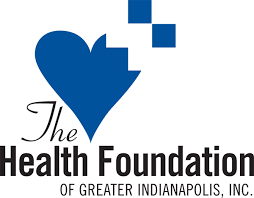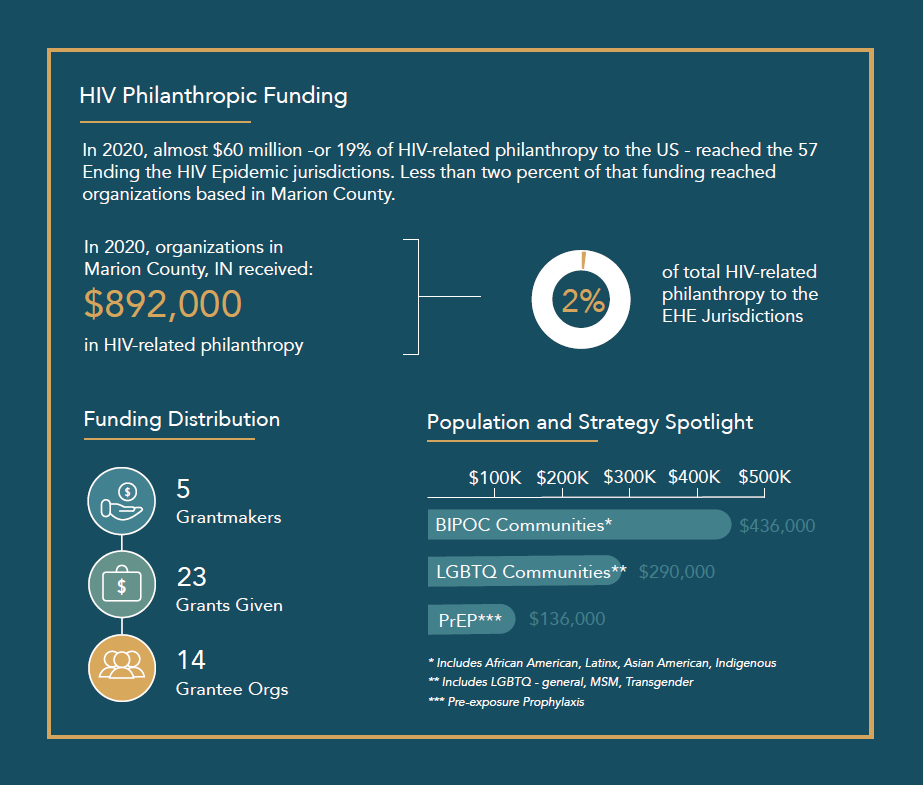What EHE Looks Like in Indiana: The Health Foundation of Greater Indianapolis
Indiana was in the throes of an HIV and Hepatitis C outbreak from injection drug use in 2014. While many accused the governor-and soon-to-be vice president Mike Pence of responding too slowly, people throughout the state sounded the alarm. The Health Foundation of Greater Indianapolis (THFGI) caught wind of the cluster of new cases and quickly summoned its partners. This urgency called for an all-hands-on-deck, statewide approach with as many resources as possible.
The outbreak emerged in November. When Indiana’s state legislature convened later that month, the representatives were asking questions about HIV – an epidemic that hadn’t made headline news in Indiana in years.

THFGI, a private foundation, is a grantmaker with specific focus on HIV prevention and emergency assistance and syringe access/harm reduction. THFGI is headquartered in Indianapolis. Located in Marion County, Indianapolis is home to about 965,000 people, including an estimated 4,800 people living with HIV (PLWH) and 170 newly-diagnosed people in 2020. Today, Marion County’s HIV epidemic is the largest in Indiana, amounting to 40 percent of all PLWH in the state and 39 percent of all new HIV diagnoses. As a result, Marion County is also one of the 57 priority jurisdictions that comprise the Ending the HIV Epidemic in the U.S. (EHE) Initiative – a ten-year federal initiative focused on the communities most affected by HIV in the U.S.
Indiana has long been home to THFGI President and CEO Jason Grisell. Grisell came to the organization as an executive assistant in 2008. During his eight years in the programs department, he directed more than $15 million in grants and funding for health-related services to Indiana’s most vulnerable populations.
He understands the conservative thinking in the state. He doesn’t agree but understands the school of thought: “There’s still an underlying current of punishing someone, or if someone contracts HIV through injection drug use, ‘Well, if they had a stronger moral character, then why don’t they just quit? Quit using drugs.’ Like it’s that easy.” In Indiana, there is a lack of empathy and understanding of what substance use disorder is and its impact on the brain.
A lack of media attention never deterred the most ardent public health proponents in Indiana from reminding people: HIV is still a crisis. Activists, organizations, and funders kept HIV in the conversation – whether funding, prevention, treatment, or care. To support this mission, THFGI established an HIV advocacy coalition in partnership with the Indiana Primary Healthcare Association – a membership affinity group for community health centers and federally qualified health centers in Indiana – and the Damien Center, one of the largest AIDS service organizations in the state.
When time came to craft a specific plan to end HIV in Marion County in late 2019 – with a goal of averting 2,000 total HIV infections in the coming decade – the relationships THFGI had forged since 1989 came in handy. The foundation, in Grisell’s words, are “the peacekeepers, the mediators, the calming force of nature in this space.” THFGI teamed up with the Marion County Health Department and Indiana Department of Health. First, they hired a local consulting firm with lots of experience in strategic planning, board development, and fundraising. The next step was gathering about 50 people to serve on the plan’s taskforce, as well as an additional task force focused on the plan’s implementation.
One major part included routine testing, which is recommended by the U.S. Centers for Disease Control and Prevention for persons between 13-64 years old.
“I think if just that [the plan] were to get implemented, we’d change the trajectory of HIV, because folks would know their status, they could talk about PrEP, and get connected [to care]. And for every infection prevented, save all this money downstream in health care costs. .We’ve got numbers to speak that language,” Grisell said.
Both in parallel and in support of the EHE plan, Grisell and his comrades in Marion, Scott, and Indiana’s 90 other counties keep working. THFGI has funded HIV since 1989 and has paid out $60 million in grants, half of which has gone to HIV efforts. They’re funding treatment, prevention, and scaling up HIV testing in primary care settings – so much beyond what’s neatly packaged in an elevator pitch.
Grisell has been with the foundation for 15 years and understands how philanthropy fills the void when grantees have been left out in the cold, comforting where federal or state dollars can’t cover. And as the HIV conversation continues to evolve, THFGI steers clear of the same old, same old.

“We lead with our checkbook because that’s what gets people’s attention. But ultimately, it ends up pushing our agencies to be creative or innovative and think outside the box,” he said. “We’re the first to admit when we’re wrong, too.”
When it comes to philanthropy, Grisell believes failure is all part of the learning process and can teach other agencies what may or may not work for them.
THFGI’s status as a private foundation affords greater flexibility in funding, whereas a health department or a government agency requires stricter adherence. For instance, a grantee may need a budget adjustment but could be reluctant to ask for it because that move may jeopardize funding. Grisell understands this well.
“We want to empower our grantees to use the funds the best way they know how to do it. And if that requires 10 budget adjustments, well okay, I can say yes 10 times,” he said. “I’d rather they do what they know they need to do. It’s not a waste of our time. That’s what we’re here for.”
Piggybacking off of Marion County’s success in crafting its EHE plan, the state followed with Zero is Possible (ZIP IN), with THFGI serving as the fiscal agent. In August of 2022, THFGI were awarded a contract in partnership with the State Department of Health and the Damien Center: $6.5 million for expansion of Hepatitis C services statewide to get individuals connected to, retained, and engaged in care & treatment. ZIP IN also places strong emphasis on strengthening mental health services. A workplace development initiative with AmeriCorps is also in the works. That way, an entry-level position serves as a leadership pipeline within their communities and will include people living with HIV.
Partnering and collaboration, Grisell said, can be scary words for a lot of our agencies. Organizations, big and small, must join forces, and depending on circumstances, that may prove difficult.
“There’s a definite fear of competition, or that there’s only so many resources to go around,” he said.
HIV philanthropy must be expansive in its mission to break silos, Grisell stresses. This means supporting nutrition programs and food pantries, transportation services, and medical transport. One organization most likely doesn’t have it all, so coordination among several organizations is essential, especially in terms of grasping social determinants of health.
Days before he spoke with FCAA for this interview, Grisell was attending a training and the conversation arose: Upstream versus Downstream. He continues, “We’re all on the water and trying to keep people from drowning, but why are they getting in the water to begin with? And if we can increase the infrastructure ahead of the bridge, so that people don’t fall in, what does that look like?”